Using red light therapy can greatly speed up your hip replacement recovery. This innovative treatment enhances tissue healing by increasing blood flow, which delivers crucial nutrients and reduces inflammation. It also promotes cellular energy production, boosting ATP levels essential for repair. Regular sessions help alleviate pain and improve joint mobility, making recovery smoother. Always make sure you choose the right device and consult your healthcare provider for best practices. Consistency is key to maximizing your results. Discover the specific techniques and tips that can elevate your recovery journey even further.
Benefits of Red Light Therapy
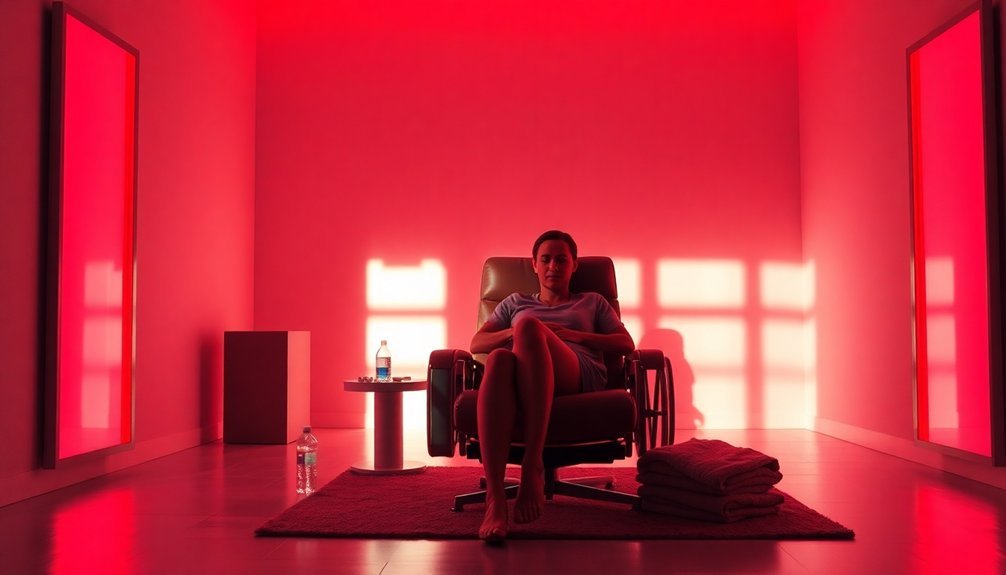
Red light therapy offers a powerful boost to your recovery process after hip replacement surgery. It promotes wound healing and tissue repair by increasing blood flow, reducing inflammation, and enhancing the production of fibroblasts, which create collagen and connective tissues. As a result, you'll notice faster healing and increased tensile strength in the affected areas. This therapy also has the ability to enhance energy production by strengthening mitochondria, which further aids in the recovery process.
This therapy also excels in reducing pain and inflammation. It does this by promoting your body's natural endorphins, blocking pain signals, and decreasing swelling. With red light therapy, you'll find that recovery isn't just quicker; it's also more comfortable.
Furthermore, red light therapy improves skin and tissue health. It enhances collagen production, which increases skin elasticity and helps reduce fine lines around your hips. The formation of new tissue accelerates the healing process for cuts and incisions, making your recovery not only faster but healthier.
Using this non-invasive treatment can transform your post-surgery experience. Many medical professionals and athletes endorse red light therapy for its convenience and efficacy. Embracing it could greatly improve both your physical recovery and mental well-being during this vital time.
Mechanism of Red Light Action
After exploring the benefits of red light therapy, it's important to understand how this treatment works to enhance your recovery. Red light therapy stimulates cellular energy production by using specific wavelengths of light that are absorbed by mitochondrial chromophores. This absorption increases mitochondrial function, leading to greater ATP production, which fuels essential cellular processes.
Moreover, red light therapy boosts blood flow by releasing nitric oxide, which dilates blood vessels, allowing more oxygen and nutrients to reach your injured hip. This enhanced circulation is vital for reducing swelling and inflammation, ensuring your recovery isn't hindered. Additionally, enhanced circulation plays a crucial role in modulating inflammation, which further supports the healing process.
Importantly, red light therapy also has anti-inflammatory effects, balancing your immune response and preventing excessive inflammation. The result? A more efficient healing process.
Here's a quick summary of how red light therapy acts to support your recovery:
| Mechanism | Effect |
|---|---|
| Cellular Energy | Increases ATP production |
| Blood Flow | Enhances circulation and nutrient delivery |
| Anti-Inflammatory | Reduces excessive inflammation |
| Tissue Repair | Stimulates fibroblast and osteoblast activity |
| Regeneration | Promotes collagen remodeling and healing |
Understanding these mechanisms can empower you to make the most out of your recovery process.
Pain Management After Surgery
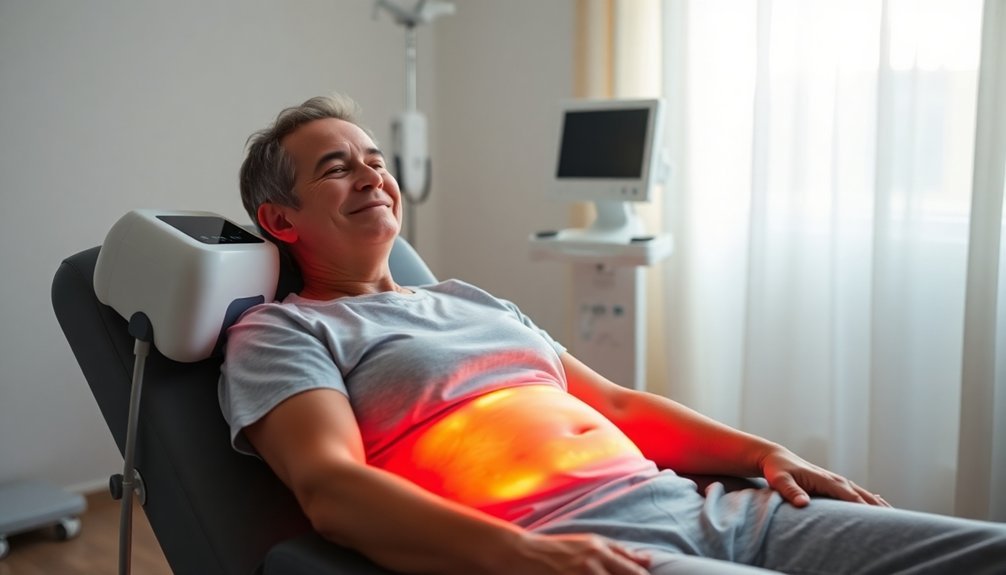
Effective pain management is crucial for a smooth recovery after hip replacement surgery. You'll want to prioritize proper medication, physical therapy, and lifestyle adjustments to help ease your discomfort. Here are key points to keep in mind:
- Medication Management: Take prescribed pain medications during the first couple of weeks, and consider non-prescription options like acetaminophen or NSAIDs to help with inflammation and pain.
- Physical Therapy: Engage in physical therapy shortly after surgery, focusing on exercises to build muscle strength and enhance joint stability. Occupational therapy can also assist with daily self-care tasks. Pain arises from pressure on surgical site and surrounding tissues when you first begin your physical therapy.
- Using Assistive Devices: Crutches or walkers can help reduce weight on your hip, minimizing pain while you heal. Maintaining a healthy weight and proper nutrition will further support recovery.
It's also important to apply the RICE method—rest, ice, compression, and elevation—after daily activities to manage discomfort.
Keep track of your pain levels and communicate with your healthcare provider, especially if it exceeds a 6 on the pain scale. Consistent and proactive pain management guarantees your journey to recovery is as smooth as possible.
Anti-Inflammatory Properties
Anti-inflammatory properties play an essential role in speeding up your recovery after hip replacement surgery. Red light therapy works on a cellular level, reducing molecules involved in inflammation like reactive oxygen species and prostaglandins. It modulates immune responses to lessen inflammation and stimulates the production of anti-inflammatory molecules.
Here's a quick overview of how red light therapy helps:
| Benefit | Description |
|---|---|
| Reduced Inflammation | Lowers swelling and discomfort around the hip area. |
| Increased Blood Flow | Enhances circulation, delivering nutrients to speed healing. |
| Improved Nutrient Delivery | Guarantees essential nutrients reach damaged tissues. |
| Reduced Oxidative Stress | Allows cells to utilize oxygen more effectively. |
| Neuroinflammation Relief | Minimizes inflammation in the brain, aiding overall recovery. |
Clinical studies indicate that red light therapy can reduce inflammation considerably, making it an effective natural treatment. By incorporating this therapy into your post-surgery routine, you can experience enhanced healing and a quicker return to your normal activities.
Selecting the Right Device
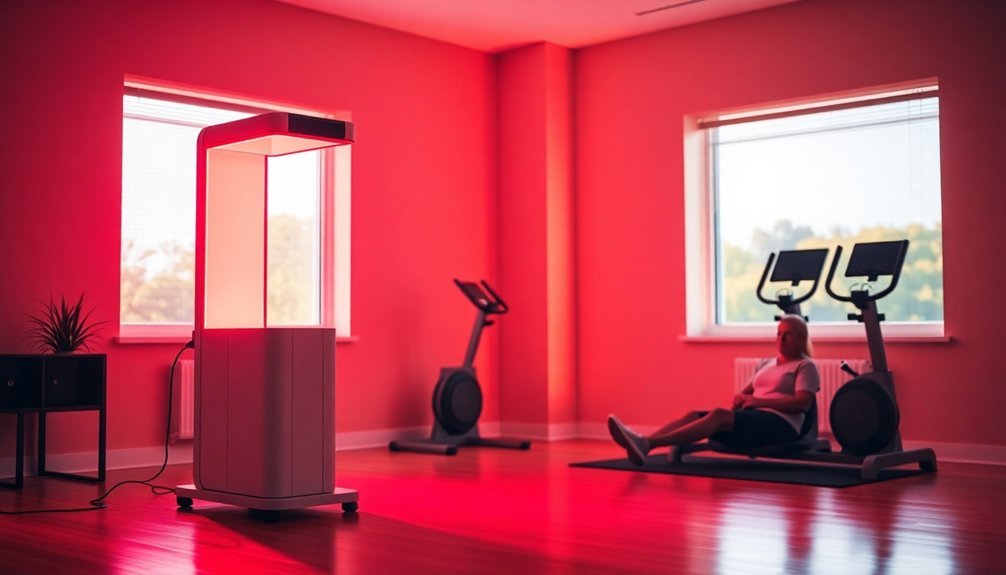
When selecting a device for your hip replacement recovery, pay close attention to the wavelengths, as they play an essential role in effectiveness.
You'll want to take into account both the optical power and coverage size of the device to guarantee it meets your needs.
Expert recommendations can guide you in choosing a product that delivers the best results for your recovery.
Wavelengths Matter Most
Choosing the right device for red light therapy can greatly influence your recovery after hip replacement surgery. When selecting a device, it's vital to focus on the wavelengths it offers. The effective range for therapeutic effects includes:
- Red light (630-700nm): Promotes blood flow and pain relief, fundamental for your recovery.
- Near-infrared light (700-850nm): Reaches deeper tissues, enhancing cellular activities and collagen production.
- Combination of 660nm and 850nm: Maximizes healing benefits for peak recovery.
You want to confirm that the device you're considering has multiple LEDs or lasers to cover these important wavelengths.
Look for devices with solid clinical backing and positive testimonials from both healthcare professionals and users. Options that allow you to adjust session times or treatment distances can better cater to your specific needs.
Don't overlook safety; verify the device is medically graded and recognized by health experts.
Power and Coverage
Finding the right red light therapy device can make a significant difference in your recovery after hip replacement surgery.
You'll want to focus on power and coverage when selecting your device. Devices use light-emitting diodes (LEDs) or laser technology to emit photons at specific wavelengths. Look for devices like the MOVE+ Pro, which offers 80mW per emission area for deep red LEDs. Higher power generally means more intense therapy, potentially speeding up results. However, the ideal power depends on your specific needs.
Coverage area also plays a significant role. Choose devices that allow you to target the hip effectively, especially those that can be strapped onto the hip. Accessories like extender straps can enhance coverage, treating multiple areas simultaneously. Confirm the device's size suits your needs for easy application without discomfort.
Finally, consistency is key. Aim to use the device daily for 5-15 minutes. Portable and easy-to-use devices are more manageable and encourage regular use, which is essential for your recovery.
Always consider user reviews and clinical support to verify you're making a reliable choice.
Expert Recommendations
Selecting the right red light therapy device can dramatically enhance your recovery process after hip replacement surgery. To guarantee you make the best selection, consider the following expert recommendations:
- Consult Healthcare Provider: Before diving into red light therapy, talk to your doctor to confirm it's right for your specific recovery needs.
- Brand Reputation and Reviews: Choose a reputable brand and check customer reviews to guarantee the device's effectiveness.
- Wavelength Effectiveness: Look for devices that utilize effective wavelengths like 660nm and 808nm to target both surface and deeper tissues.
Additionally, prioritize devices that offer a combination of LED and laser technology for better results.
Focus on using the device consistently, aiming for 20 to 30 minutes daily. This routine helps maximize your recovery benefits.
Don't overlook features like flexibility and portability, as they'll enhance your treatment experience.
Finally, opt for devices that stimulate ATP production and collagen synthesis to support healing and reduce inflammation.
With the right device, you'll set yourself up for a smoother and quicker recovery.
Usage Guidelines for Therapy
When using red light therapy, it's essential to follow specific session duration and frequency guidelines to maximize your recovery.
Aim for daily sessions lasting between 5-15 minutes, adjusting based on your comfort and healing needs.
Always prioritize safety precautions to guarantee effective and risk-free therapy.
Session Duration Recommendations
For those looking to enhance their recovery from hip replacement, incorporating red light therapy into your daily routine can be highly effective.
It's vital to balance session duration and frequency to achieve ideal results. Here are some duration recommendations:
- Keep sessions short: Aim for 5-15 minute sessions to fit easily into your day.
- Stay consistent: Daily sessions are important for integrating this therapy into your routine.
- Don't hesitate to repeat: Multiple sessions a day can amplify benefits.
Even brief sessions can trigger healing and alleviate pain considerably.
Ideally, find a time that suits you best—whether it's during your lunch break or while winding down at night. The key is consistency, as daily use enhances tissue healing, circulation, and collagen production.
Studies suggest that just 10-20 minutes of red light therapy can yield impressive results, such as reducing pain and inflammation by up to 70%.
Frequency of Use
To get the most out of your red light therapy for hip replacement recovery, consistency is essential. Aim to use the therapy at least three to four times a week, but daily sessions can greatly enhance your recovery speed. Incorporating this into your routine helps reduce pain and inflammation effectively.
When starting, use short sessions lasting about 2-3 minutes and gradually increase the duration. Begin with therapy every other day and progress to daily use as your body adapts. Make sure you don't exceed 20 minutes per session, and always monitor how your body responds to any adjustments.
You can maximize the benefits of red light therapy by using it alongside your physical therapy sessions. It's effective before or after these sessions, complementing your rehabilitation exercises.
Also, consider combining it with other recovery methods like icing and elevating your leg.
Over time, you'll likely feel the benefits within 1-4 weeks of regular use. Even after your initial recovery, consider continuing the therapy to maintain joint health and prevent future complications.
Adjust the frequency based on how your body responds, guaranteeing continued improvement in your mobility.
Safety Precautions
As you incorporate red light therapy into your recovery routine, it's crucial to follow safety precautions to guarantee the best outcomes. Here are some guidelines to keep in mind:
- Consult your healthcare provider: Always talk to your doctor before starting red light therapy. They can advise you on when to begin and confirm it won't interfere with your healing process.
- Choose the right device: Select a red light therapy device that's FDA-cleared and backed by clinical studies. Confirm it's suitable for your treatment area, whether handheld or a larger panel.
- Use it correctly: Position the device so the infrared light directly targets your surgical site. Wrap pads around areas with pain, but avoid using them on open wounds until they're fully healed.
Red light therapy is generally safe and non-invasive when used properly. However, it's crucial to watch for any contraindications.
With your doctor's guidance, you'll be on the right path toward effective recovery while reaping the benefits of this therapy. Stay informed and make certain you're using it safely for the best results!
Enhancing Tissue Regeneration
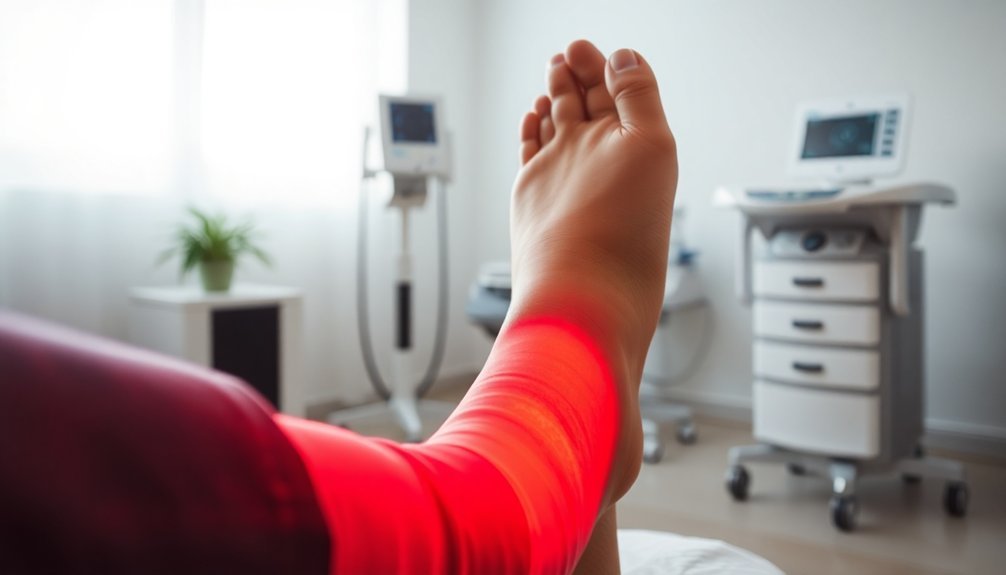
Tissue regeneration plays an essential role in your recovery after hip replacement surgery, and red light therapy can greatly enhance this process. By stimulating the release of nitric oxide, red light therapy boosts blood flow, which increases oxygen and nutrient delivery to the injured area. This improved circulation aids in the repair of damaged tissues while helping to reduce swelling and inflammation, contributing to a quicker recovery.
Moreover, red light therapy triggers the production of ATP, critical for your cellular energy. This energy boost supports cellular repair and enhances mitochondrial function, reducing oxidative stress. The result? Faster healing and improved tissue health.
The therapy also helps modulate inflammation by lowering levels of pro-inflammatory cytokines, creating a more favorable healing environment. Less inflammation means less pain, improving your overall comfort during recovery.
Finally, red light therapy promotes collagen synthesis and encourages the mobilization of stem cells, both essential for effective tissue repair. By addressing multiple aspects of tissue regeneration, red light therapy guarantees you're equipped with the best possible conditions for recovery after your hip replacement surgery.
Improving Joint Mobility
Improving your joint mobility is essential for a smooth recovery after hip replacement surgery.
By focusing on enhanced flexibility and incorporating effective pain reduction techniques, you can accelerate your healing process.
Let's explore how these strategies can make a significant difference in your recovery journey.
Enhanced Flexibility
Many patients who've undergone hip replacement surgery struggle with stiffness and limited mobility, but enhanced flexibility can greatly improve your recovery.
One effective way to boost flexibility is through red light therapy. It reduces inflammation—a key factor in joint stiffness—helping you regain mobility.
Here are some benefits of red light therapy for enhanced flexibility:
- Reduced Stiffness: Anti-inflammatory effects can alleviate morning stiffness considerably, making daily activities easier.
- Improved Blood Circulation: Increased blood flow enhances oxygen and nutrient delivery, supporting joint health.
- Better Tissue Repair: The therapy promotes cellular regeneration, leading to enhanced joint function after surgery.
Pain Reduction Techniques
Effective pain reduction techniques are essential for enhancing joint mobility after hip replacement surgery. You can start by using over-the-counter pain relievers like acetaminophen or NSAIDs to reduce inflammation and discomfort. Always follow the recommended dosage to avoid negative side effects. Your orthopedic surgeon will likely prescribe medications tailored to your specific pain management needs, so keep in touch with them.
Engaging in physical therapy is another important step. A qualified physical therapist can design a program with tailored exercises that promote muscle strength, flexibility, and joint stability. Simple exercises like straight leg raises, standing knee raises, and standing hip extensions can facilitate your recovery without increasing pain.
Using assistive devices, like crutches or walkers, will help you reduce weight-bearing pain while moving. Additionally, maintaining a healthy weight and proper nutrition can greatly ease strain on your new joint. Staying hydrated will also support tissue repair.
Finally, consider incorporating red light therapy. This innovative technique enhances blood circulation, reduces inflammation, and promotes faster recovery by blocking pain signals and increasing endorphins.
Integrating Therapy Into Recovery
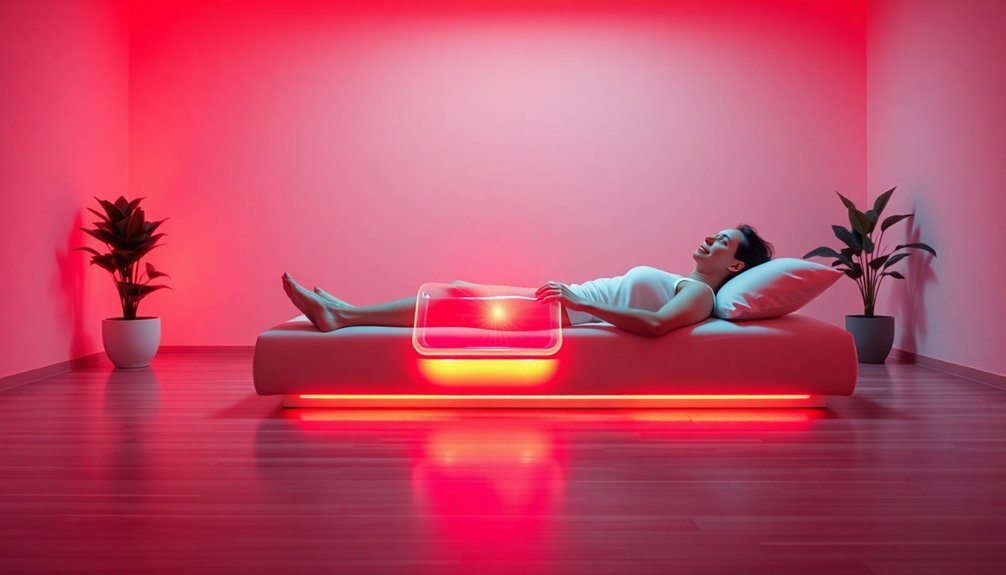
Integrating various therapies into your recovery plan can greatly enhance outcomes after hip replacement surgery. One particularly effective method is red light therapy, which can greatly aid in your healing process. By reducing pain and inflammation, it sets the stage for a smoother recovery.
Consider these benefits when incorporating red light therapy into your routine:
- Pain Relief: It promotes natural endorphins and blocks pain signals, making your recovery more manageable.
- Improved Circulation: By increasing blood flow, it delivers more oxygen and nutrients to the injured area, which is vital for healing.
- Tissue Regeneration: It stimulates collagen production and tissue repair, leading to quicker recovery times.
Before diving in, consult your healthcare provider to confirm red light therapy is suitable for you. Wait until any open wounds have healed before starting.
Once given the green light, integrate this therapy into your daily routine for best results. Whether you choose an at-home device or visit a clinic, aim for consistent application, typically 5-15 minutes daily, to reap the full benefits and support your physical therapy efforts.
Monitoring Recovery Progress
Monitoring your recovery progress after hip replacement surgery is essential for ensuring a smooth and effective rehabilitation journey. Using devices like Fitbit ankle accelerometers at home can help you keep track of your mobility and activity levels.
Studies show that patients averaged 26.7 days of device use in the first 30 days post-surgery, greatly increasing their daily steps from 235 to 2563. Younger patients under 70 tend to be more active, while those who undergo the anterior surgical approach can also expect higher activity levels.
In addition to tracking activity, you'll want to assess your recovery through various clinical metrics. Regularly testing your range of motion, gait speed, and performing functional tests like the 30-Second Chair Stand Test can provide insight into your progress.
You should aim for strength levels greater than 90% compared to your uninvolved hip, ensuring you can perform daily activities pain-free. Following specific discharge criteria, such as independently completing activities of daily living, will guide your progress.
Monitoring both your physical metrics and consulting with your healthcare team will empower you to navigate your rehabilitation journey effectively.
Frequently Asked Questions
Can Red Light Therapy Be Used Alongside Other Treatments?
Yes, you can use red light therapy alongside other treatments. It complements therapies like electrical stimulation and SoftWave, enhancing muscle strength and overall rehabilitation while promoting faster healing and pain relief without adverse effects.
Are There Any Side Effects From Red Light Therapy?
Yes, you might experience side effects from red light therapy, such as headaches, eye strain, or skin irritation. It's important to follow usage guidelines and consult your doctor if you have any concerns before starting treatment.
How Long Before I See Results From Therapy?
You can usually see results from therapy within 1-4 weeks, experiencing reduced pain and inflammation. The extent of improvement varies, but early benefits often include enhanced mobility and tissue repair, leading to quicker healing.
Is Red Light Therapy Safe for All Patients?
Red light therapy's generally safe for most patients, but you should consult your healthcare provider, especially if you have surgical implants or specific medical conditions, to guarantee it's appropriate for your situation and healing process.
Do I Need a Prescription for Red Light Therapy Devices?
You don't necessarily need a prescription for red light therapy devices, but having one can improve your insurance coverage chances. Consulting with your healthcare provider is key to determining if it's medically necessary for you.
In Summary
Incorporating red light therapy into your hip replacement recovery can greatly enhance your healing process. With its ability to reduce inflammation, manage pain, and promote tissue regeneration, you're setting yourself up for a smoother recovery. By choosing the right device and integrating this therapy into your routine, you'll likely notice improved joint mobility and overall progress. Don't underestimate the power of red light therapy—it could be a game-changer in getting you back on your feet faster!

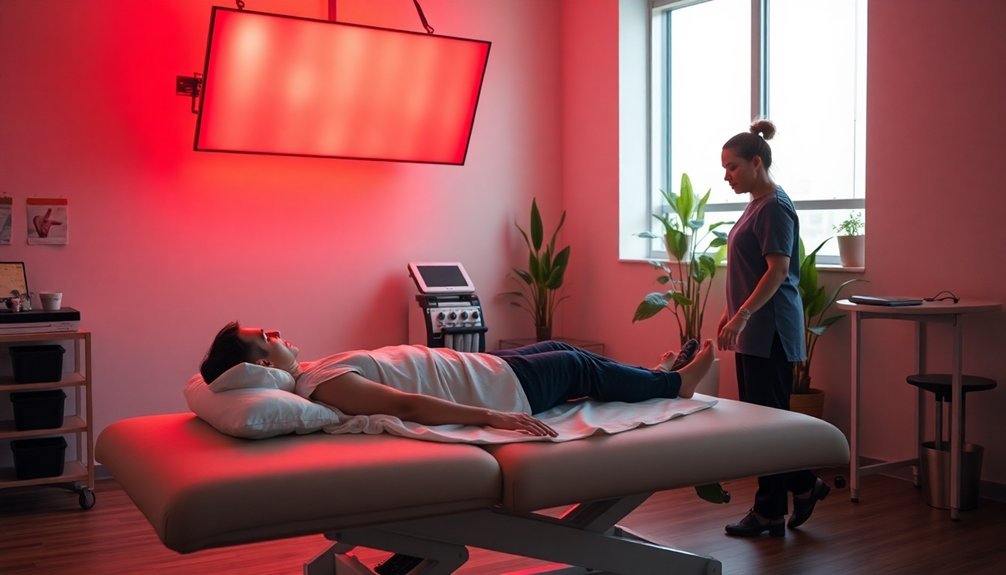



Leave a Reply